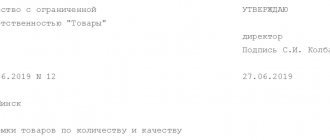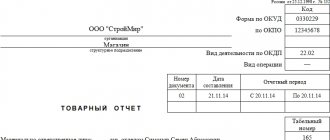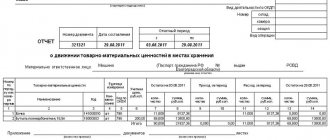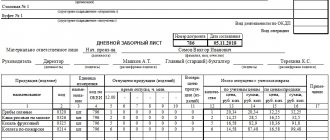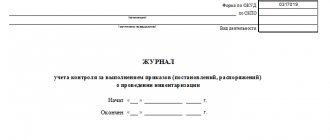Monthly reporting of statistics on the turnover of wholesale trade of a small enterprise
Monthly PM-torg form - how to fill out? The report “Information on wholesale trade turnover of a small enterprise” is easy to fill out; it contains only one indicator - wholesale trade turnover, which is indicated for several periods:
- for the reporting month;
- for the past month;
- for the same month last year.
When filling out information for the reporting company, you must indicate:
- the full name of the organization and write a short name next to it in brackets;
- index and legal address of the company, if the location differs from registration, then note the actual address;
- OKPO, assigned by statistics, this code can be “seen” in the form of a balance sheet in the organization’s code line.
After filling out the report, it is signed by the head of the company or the official responsible for reporting, the telephone number and date of preparation are indicated - and the report can be considered ready if you know the nuances of the presentation and what income is not considered wholesale turnover for the purpose of filling out this information. This will be discussed further in the article.
The PM-torg form is filled out on a form approved by Rosstat order No. 321 dated July 16, 2015, and is submitted monthly to the territorial statistics body, the deadline for submission is the 4th of the previous month.
Where and when to submit the PM-torg form
All legal entities - small businesses in the field of wholesale trade - report using the PM-torg form. Micro-enterprises, medium and large companies are exempt from filing these reports. Reports can be submitted to Rosstat in electronic or paper form.
Report monthly to the territorial body of state statistics. Deadline: 4th day of the month following the reporting month. If the 4th falls on a weekend or holiday, the due date is shifted to the next business day. If there are branches or divisions, a single generalized PM-torg form is submitted.
Who must submit reports?
Not all enterprises have an obligation to provide (see figure):
Don't know your rights? Subscribe to the People's Adviser newsletter. Free, minute to read, once a week.
The following are not exempt from submitting the form:
- small enterprises on a simplified taxation system - they submit reports according to generally accepted rules;
- firms that have worked for an incomplete reporting period are required to submit the PM-torg form, indicating in writing the period of inactivity;
- companies in bankruptcy - only after making an entry about liquidation in the Unified State Register of Legal Entities, the organization is exempt from submitting a report.
Presentation nuances:
- Legal entities provide information at the place of registration; if there is no activity at the location, the company sends a report to the place of activity.
- If the company includes branches and divisions located in different regions, reporting is submitted as a whole for the entire organization at its place of registration.
- The main business company submits a report without taking into account the turnover of subsidiaries and dependent companies, which, in turn, also provide information on their activities in a separate form.
- If the company is in trust management, then the enterprise carrying out management is accountable for it as for an entire property complex.
- Enterprises operating under a simple partnership agreement distribute wholesale trade turnover in proportion to their contributions, unless this contradicts their agreement, and each entity submits a report. If it is impossible to distribute the proceeds, the PM-torg form is submitted by the comrade performing reporting duties.
- If there are no reporting indicators, you should send a letter about this to the statistical office. This must be done every time the form is due, since zero reports are not submitted to Rosstat, and penalties for failure to submit may be assessed (letter of Rosstat dated January 22, 2018 No. 04-4-04-4/6-smi).
Any company can be included in a sample survey organized by a statistical agency. In this case, Rosstat notifies the enterprise in writing of the need to report on this form.
What applies to wholesale trade?
Wholesale trade for the purpose of filling out the main indicator in line 01 of the PM-trading form is considered to be:
- the cost of goods shipped with the obligatory completion of an invoice;
- proceeds from goods sold purchased for subsequent sale to legal entities and individual entrepreneurs for further use or resale;
- if the turnover includes the sales price with a markup, VAT, excise tax, customs duty, and all mandatory payments;
- for commission agents (agents) - remuneration if they carry out activities in the interests of another person (principal, principal) is reflected with value added tax at the actual cost;
- for principals - the turnover of trade carried out by the principal (principal) on the basis of commission agreements or agency agreements is indicated at the cost of goods sold.
Turnover on line 01 is indicated in thousands of rubles with one decimal place after the decimal point.
The following is not considered a wholesale sale for the purpose of completing this statistical report:
- sales of products to the public, since this is retail trade;
- revenue from the sale of fuel cards, telephone cards, communication services, as well as from the sale of lottery tickets;
- the cost of utilities provided to the population and enterprises (gas, water supply, electricity).
***
Statistical reporting in the PM-torg form is mandatory for small wholesale businesses (except micro-enterprises). Retail trade organizations do not submit this report. When completing the main indicator, you must include turnover, which is considered wholesale only for the purpose of completing this report form. This information is submitted to Rosstat monthly on the 4th of the previous month.
Filling out the report title page
Completing the report should begin with the title page. It contains all the information about the organization and the report itself. Conventionally, the information on the title page can be divided into three blocks.
| Form indicator | Decoding |
| Block 1 | |
| Report form name | The title of the report is already typed into the form itself. |
| Month and year | In this line you must indicate the month and year for which the report form is being submitted. |
| Block 2 | |
| Who provides | The title page contains information that the report must be submitted to legal entities engaged in wholesale trade |
| Form submission deadline | The deadline for submitting the form is the 4th of each month. |
| Short name and what it is approved for | The form has the short name PM - bargaining and is approved by order of Rosstat. This information is reflected on the right side of the sheet |
| Frequency of reporting | The report form is monthly |
| Block 3 | |
| Company name | It is necessary to indicate the full or abbreviated name of the organization submitting the report |
| Location address | The company's postal address is indicated here |
| Digital report code | Each form is assigned its own OKUD code. Specifically for the MP form - bargaining it is 0614008 |
| OKPO code | It is necessary to indicate the OKP code of the organization, since for the statistics body this is the main code for identifying taxpayers |
After the title page is completed, you can proceed to filling out the main reporting table.
Filling out the main section of the form
The second sheet of the report is the actual information about wholesale trade turnover.
It should be noted here that such turnover is expressed in actual sales prices, including all mandatory taxes and fees, and represents revenue from the sale of goods purchased by the organization for resale (that is, the amounts for filling out this form must be viewed in account 90.01). In this case, there must be an invoice for shipment. The amount that is the remuneration of commission agents is also shown in fact, including VAT. All data in the table is indicated in thousands of rubles, with 1 decimal place.
Another important nuance that is relevant for some companies: the transfer and distribution of resources such as gas, electricity and heat to consumers does not fall under the concept of wholesale trade, and therefore is not reflected in the report.
The tabular part of the main section consists of five columns. The last three columns are reserved for reflecting indicators over time: for the current month, the previous month and the same month of the last year. In this way, you can track the development of sales over time.
After filling out the tabular part, the person who is responsible for filling out the form must sign and decipher it. In addition, a contact telephone number for communication is indicated, and you can also write down an email address. The report date is usually the date the form is submitted to the statistics office.
The structure of the report and the procedure for filling it out
Instructions for filling out the form are given in the same Rosstat orders that approved their forms. There are no fundamental updates in the instructions due to changes in the form.
The report consists of:
- from the organizational (introductory) part, filled in with a standard set of information about the reporting company;
- 3 main sections.
Section 1 “Retail trade turnover”
The section is represented by a table of 4 columns and 5 lines. It provides data as of the reporting date in comparison with the same period last year.
Retail trade volume is reflected in actual sales prices, which include:
- trade margin;
- VAT;
- similar mandatory payments.
Data in the report should not include retail trade turnover:
- in the form of the cost of goods sold at retail to firms and individual entrepreneurs;
- catering turnover
The retail turnover reflected in the report includes those transactions that are confirmed by a cash receipt or a document replacing it.
The section contains data:
- on retail trade turnover with detailed data on food products and methods of sale (via the Internet or by post);
- on the stock of goods for sale to the public at the end of the period.
The article “Distribution trade on UTII: features of legislation” will tell you about the tax nuances of one of the types of retail trade.
Section 2 “Retail sales and inventories of goods by type”
The second section of the report explains the figures from section 1 on retail turnover and product inventories. Explanations are given in lines 06–82 at the cost of certain types of food and non-food products sold to the population and in stock at the end of the reporting period (meat, fish, dairy products, fresh fruit, vacuum cleaners, refrigerators, televisions, shoes, building materials, medicines, etc. ).
Each product group in the report is listed under the corresponding code from the classifier of products by type of economic activity (OKPD2).
Section 3 “Number of gas stations”
Lines 83–85 of the third section of the report are filled out once a year - only in reporting for the 1st quarter. It includes information on the number of gas stations with details by type of gas station:
- multi-fuel (MTZS);
- gas filling stations (CryoGZS, CNG filling stations, AGZS).
Read about the nuances of using modern cash registers for the retail sale of gasoline in the material “Online cash registers for gas stations from 2020 - explanations.”
Responsibility for violations when submitting a report
Everyone knows that failure to provide reporting entails liability. Moreover, it does not matter what kind of report we are talking about - tax or any other.
Until recently, statistical authorities were very loyal to taxpayers who “forgot” to submit statistical forms or did so with errors. Currently, the situation has changed and serious penalties are provided for such violations.
If a taxpayer submits incorrect information to the statistics agency or violates the established procedure for submitting forms, then for the first time you can get by with a fine for responsible persons in the amount of 10,000 to 20,000 rubles, but the companies themselves will have to fork out 20,000 to 70,000 rubles.
If a repeated violation of the requirements occurs, this is fraught with very serious fines: from 30,000 to 50,000 rubles for responsible persons and from 100,000 to 150,000 rubles for the organization itself.
Therefore, to avoid such a situation, you need to take the form seriously and submit it to the statistics department on time.
As you can see, the report is as simple as possible, consisting of only one indicator. The form is monthly, due by the 4th of each month. Only commercial organizations engaged in wholesale trade should generate and submit reports. You need to be careful when filling out the report and not be late in submitting it, because otherwise both the organization and the responsible person will face large fines, especially if there is a repeated violation. When filling out the form manually, you must ensure that the report form is up to date. If you have any difficulties filling out, it is better to refer to the Instructions for filling out.
How to fill out a non-compliance report for imported goods
TORG-3 is drawn up in 5 identical copies, which is 1 copy more than when filling out a similar act, which is generated when the quality and quantity of domestically produced goods and materials do not correspond (we are talking about the TORG-2 form). In this case, there is no need to affix stamps on all 5 copies.
TORG-3 indicates the actual availability of goods and materials received from abroad - the relevant data is taken from the accompanying documents. But data on the planned completeness and quality of arriving goods and materials must be taken from the supply contract.
TORG-3 forms are compiled separately for each batch of goods and materials received under a single accompanying document, and for each supplier. If upon acceptance of a consignment of goods no discrepancies were identified for any of the items, then this item is not entered in the tabular part of the act, however, at the end of the document it should be indicated that no discrepancies were identified for other (not listed in the act) inventory items.
The executed acts, together with the accompanying documentation, are handed over to the accountant against signature. Next, the recipient of the goods and materials prepares a claim to the supplier (or carrier) based on the recorded facts.
TORG-3 consists of 3 pages. The 1st page reflects the available information about the supplier/buyer and the method of transportation. On the 2nd page information about the detected discrepancy is indicated, while data from shipping documents and actual data are entered.
The need to fill out the 3rd page of the act arises only when there is no need to conduct expert research. This is justified in situations where the discrepancy is due to underdelivery or incomplete delivery. If the delivery of low-quality products is discovered or the cargo was damaged during transportation, then an examination must be carried out, involving an independent organization.
Topic: PM-bargaining
Quick link Documentation and reporting Up
- Navigation
- Cabinet
- Private messages
- Subscriptions
- Who's on the site
- Search the forum
- Forum home page
- Forum
- Accounting
- General Accounting Accounting and Taxation
- Payroll and personnel records
- Documentation and reporting
- Accounting for securities and foreign exchange transactions
- Foreign economic activity
- Foreign economic activity. Customs Union
- Alcohol: licensing and declaration
- Online cash register, BSO, acquiring and cash transactions
- Industries and special regimes
- Individual entrepreneurs. Special modes (UTII, simplified tax system, PSN, unified agricultural tax)
- Accounting in non-profit organizations and housing sector
- Accounting in construction
- Accounting in tourism
- Budgetary, autonomous and government institutions
- Budget accounting
- Programs for budget accounting
- Banks
- IFRS, GAAP, management accounting
- Legal department
- Legal assistance
- Registration
- Inspection experience
- Enterprise management
- Administration and management at the enterprise
- Outsourcing
- Enterprise automation
- Programs for accounting and tax accounting Info-Accountant
- Other programs
- 1C
- Electronic document management and electronic reporting
- Other tools for automating the work of accountants
- Clerks Guild
- Relationships at work
- Accounting business
- Education
- Labor exchange Looking for a job
- I offer a job
- Club Clerk.Ru
- Friday
- Private investment
- Policy
- Sport. Tourism
- Meetings and congratulations
- Author forums Interviews
- Simple as a moo
- Author's forum Goblin_Gaga Accountant can...
- Gaga's opusnik
- Internet conferences
- To whom do I owe - goodbye to everyone: all about bankruptcy of individuals
- Archive of Internet conferences Internet conferences Exchange of electronic documents and surprises from the Federal Tax Service
- Violation of citizens' rights during employment and dismissal
- New procedure for submitting VAT reports in electronic format
- Preparation of annual financial/accounting statements for 2014
- Everything you wanted to ask the electronic document exchange operator
- How to turn a financial crisis into a window of opportunity?
- VAT: changes in regulatory regulation and their implementation in the 1C: Accounting 8 program
- Ensuring the reliability of the results of inventory activities
- Protection of personal information. Application of ZPK "1C:Enterprise 8.2z"
- Formation of a company's accounting policy: opportunities for convergence with IFRS
- Electronic document management in the service of an accountant
- Time tracking for various remuneration systems in the program “1C: Salary and Personnel Management 8”
- Semi-annual income tax report: we will reveal all the secrets
- Interpersonal relationships in the workplace
- Cloud accounting 1C. Is it worth going to the cloud?
- Bank deposits: how not to lose and win
- Sick leave and other benefits at the expense of the Social Insurance Fund. Procedure for calculation and accrual
- Clerk.Ru: ask any question to the site management
- Rules for calculating VAT when carrying out export-import transactions
- How to submit reports to the Pension Fund for the 3rd quarter of 2012
- Reporting to the Social Insurance Fund for 9 months of 2012
- Preparation of reports to the Pension Fund for the 2nd quarter. Difficult questions
- Launch of electronic invoices in Russia
- How to reduce costs for IT equipment, software and IT personnel using cloud power
- Reporting to the Pension Fund for the 1st quarter of 2012. Main changes
- Income tax: nuances of filling out the declaration for 2011
- Annual reporting to the Pension Fund. Current issues
- New in financial statements for 2011
- Reporting to the Social Insurance Fund in questions and answers
- Semi-annual reporting to the Pension Fund in questions and answers
- Calculation of temporary disability benefits in 2011
- Electronic invoices and electronic primary documents
- Preparation of financial statements for 2010
- Calculation of sick leave in 2011. Maternity and transition benefits
- New in the legislation on taxes and insurance premiums in 2011
- Changes in financial statements in 2011
- DDoS attacks in Russia as a method of unfair competition.
- Banking products for individuals: lending, deposits, special offers
- A document in electronic form is an effective solution to current problems
- How to find a job using Clerk.Ru
- Providing information per person. accounting for the first half of 2010
- Tax liability: who is responsible for what?
- Inspections, collection, refund/offset of taxes and other issues of Part 1 of the Tax Code of the Russian Federation
- Calculation of sick sheets and insurance premiums in the light of quarterly reporting
- Replacement of unified social tax with insurance premiums and other innovations of 2010
- Liquidation of commercial and non-profit organizations
- Accounting and tax accounting of inventory items
- Mandatory re-registration of companies in accordance with Law No. 312-FZ
- PR and marketing in the field of professional services in-house
- Clerk.Ru: design change
- Building a personal financial plan: dreams and reality
- Preparation of accounting reporting. Changes in Russia accounting standards in 2009
- Kickbacks in sales: pros and cons
- Losing a job during a crisis. What to do?
- Everything you wanted to know about Clerk.Ru, but were embarrassed to ask
- Credit in a crisis: conditions and opportunities
- Preserving capital during a crisis: strategies for private investors
- VAT: deductions on advances. Questions with and without answers
- Press conference of Santa Claus
- Changes to the Tax Code coming into force in 2009
- Income tax taking into account the latest changes and clarifications from the Ministry of Finance
- Russian crisis: threats and opportunities
- Network business: quality goods or a scam?
- CASCO: insurance without secrets
- Payments to individuals
- Raiding. How to protect your own business?
- Current issues of VAT calculation and reimbursement
- Special modes: UTII and simplified tax system. Features and difficult questions
- Income tax. Calculation, features of calculus, controversial issues
- Accounting policies for accounting purposes
- Tax audits. Practice of application of new rules
- VAT: calculation procedure
- Outsourcing Q&A
- How can an accountant comply with the requirements of the Law “On Personal Data”
- The ideal archive of accounting documents
- Service forums
- Archive FAQ (Frequently Asked Questions) FAQ: Frequently Asked Questions on Accounting and Taxes
- Games and trainings
- Self-confidence training
- Foreign trade activities in harsh reality
- Book of complaints and suggestions
- Diaries
The Federal State Statistics Service collects information on the turnover of small enterprises engaged in wholesale trade. To collect such information, Rosstat Order No. 321 dated July 16, 2015 (as amended on August 28, 2017) approved the monthly PM-torg form. Data is filled in for the organization as a whole, that is, for all “isolations” (branches and structural divisions), regardless of their location.
PM-trading – who submits this report? This form is submitted by all legal entities - small businesses (with the exception of micro-enterprises) engaged in wholesale trade. provide information on trade turnover on a general basis. If the organization is temporarily not operating, but trade was still carried out for part of the reporting period, it is necessary to submit information about turnover in the general manner (indicating the date of suspension of activity).
PM-bargaining – due date: until the 4th day of the month following the reporting month (inclusive). The organization fills out the current form for providing information and submits it to the territorial body of Rosstat at its location. If the activity is not carried out at the location, then the form must be submitted to the place where the activity is actually carried out.
PM-bargaining – filling
Under the name of the form, you must indicate the month and year for which information is being submitted. Under the general information (deadlines for submission, who should provide information, etc.), the name of the reporting organization is entered. The name is indicated in the following order: the full name is entered as indicated in the constituent documents, and the abbreviated name is indicated in brackets.
Next, in the PM-Trading (statistics) report, the postal address of the organization is filled in. In this line you must indicate the legal address (with postal code). If the actual and postal addresses are different, the actual address is also indicated. In the code part of the table it is necessary to indicate the OKPO code.
Filling out the PM-torg form should not cause any difficulties - the form is not voluminous. In fact, the form contains only one main indicator - wholesale trade turnover for several periods. This information is reflected in a small table of five columns.
- Indicator name – wholesale trade turnover;
- Line number;
- Turnover for the reporting month;
- Turnover for the previous month;
- Turnover for the same month last year.
If PM-trading is filled out by a commission agent or agent (one who acts in the interests of another person), then only the amount of the remuneration received is indicated.
There is no need to indicate income from the sale of goods to the public - this turnover does not apply to wholesale trade. Wholesale trade turnover also does not include the cost of lottery tickets, telephone cards, cards for express payment for communication services, and fuel cards.
Turnover is given in actual sales prices, including trade margins, VAT, excise taxes, customs duties and other mandatory payments.
Organizations that are submitting information for the first time do not have to worry about not being able to complete the PM-torg process – the instructions for filling out are very simple. At the end of the article, you will be able to download the current sample form and use it to fill out your report.
The form must be signed by the general director or the person responsible for submitting information to Rosstat, indicating the position and full name. It is also necessary to indicate contact information (phone number, email) and the date the report was completed.
It must be remembered that administrative liability is provided for providing incorrect information, as well as for violating the submission procedure. Violations may entail a fine for officials of the organization in the amount of 10-20 thousand rubles, for legal entities - from 20 to 70 thousand (Article 13.19 of the Code of Administrative Offenses of the Russian Federation). If this violation occurs again, the fines may be increased (the fine for a legal entity in this case will be 100-150 thousand rubles, the official will pay 30-50 thousand rubles).
Features of commission acceptance
To accept imported goods (in the event of a discrepancy between the actual data and those specified in the contract), a special commission is always created under the TORG-3 act. The commission should include representatives of both the recipient and the supplier. If it is not possible to ensure the presence of a representative of the supplier, then a representative of any third-party organization that is not interested in the results of the cargo inspection may be included in the commission instead.
At the same time, it is important that this third-party representative is competent in matters of acceptance of goods in terms of quantity and quality. Usually, employees of the Chamber of Commerce and Industry (CCI) are involved as a third party. It is important to obtain the supplier’s consent to accept the goods in the absence of his representative.
If consent was not received, but the representative did not arrive, then a representative of the Chamber of Commerce and Industry is definitely called for acceptance in order to avoid costs for downtime of the freight transport. It is important that the recipient be able to prove that he notified the supplier of the discrepancy and asked to send a representative.
Completing section 1
In the first line, it is necessary to indicate the turnover of retail sales of goods, which generates cash income from the sale of products to the public for use for business purposes or for personal consumption.
Legislation allows the following to be included in the retail sales of goods:
- cash sales;
- payment by credit cards;
- sales using bank checks,
- purchase from the depositor's account;
- sales without opening an account on behalf of an individual;
- sale via payment card;
- payment under a commission agreement;
- purchase via bank transfer with postal delivery;
- purchase with credit funds;
- sales of durable products according to images;
- purchasing goods in online stores;
- selling products through a vending machine;
- sale of medicines that are provided to certain categories free of charge or at a discount;
- sale of goods (for example, fuel) to certain groups of the population at discounts;
- payment for subscriptions to printed publications;
- sale of packaging that is not included in the price of the product;
- price of empty containers.
Principals, principals and principals who are the owners of the products are not required to fill out line No. 1.
Line No. 3 contains information about the turnover of retail sales of products sold on the Internet.
Line No. 4 is intended for statistics of data on the turnover of products sold by mail.
Columns 3 and 4 in line No. 5 reflect the inventories of products that will be sold to the population. Inventories are valued based on average prices for similar products. The relevance of the price must be checked quarterly, that is, every time the 3rd TORG PM 2017 is filled out. If the price has increased or decreased, you need to re-evaluate and indicate the current average price in the new form.
The fifth line is forced to be filled out only by the owners of goods, and not by companies that trade in the interests of other persons.
Sample report on retail turnover
Let's look at an example of how to fill out form 3-TORG (PM).
LLC "Molochnaya Dolina" is a small enterprise engaged in the sale of dairy products to the population. In 2020, through a network of retail stores, Molochnaya Dolina LLC sold milk, fermented baked milk, kefir, sour cream, cottage cheese and cheese in the amount of RUB 12,341,000. Inventories of dairy products as of December 31, 2017 amounted to RUB 4,987,670 in value equivalent.
When registering 3-TORG (PM), a company is required to fill out the introductory part, section 1 and 3 explanatory lines from section 2 (17–21), taking into account the following detail:
| Report line | Name of product | Product group details |
| 17 | Dairy | Data on retail sales and inventories of dairy products |
| 18 | Of them: Drinking milk | Retail and Inventory Data:
|
| 19 | Dairy drinks | Sales value and inventory data:
|
| 20 | Fat cheeses | Information about retail sales of cheese |
| 21 | Canned milk powder, freeze-dried | Cost of sold powdered and freeze-dried milk and its balance at the end of the quarter |
See below for a sample report filled out using this data.
How to fill out section No. 2?
The second section is intended to decrypt the information specified in line No. 1 of the first section. In lines 6 to 82 you need to classify products by product groups in price terms:
- lines 6-11 are devoted to the classification of meat products depending on the type of animal, living environment and method of partial or complete preparation for consumption;
- lines 13-15 are for the classification of edible oils;
- line No. 16 contains data on retail sales and inventories of margarine products;
- lines 17-19 are devoted to fermented milk products;
- line No. 23 contains the classification of goods sold and stocks of sugar, as well as sugar substitutes;
- lines No. 24 and 28 indicate stocks of flour and flour product concentrates;
- line No. 25 contains information about stocks of tea, coffee, cocoa, capsules for coffee machines, as well as coffee and tea gift sets;
- in line 29 an entry is made about the supply of cereals and baby food;
- line No. 31 contains the classification of stocks of crackers, bread, croutons and other bakery products;
- line No. 35 contains information about alcoholic beverages;
- line No. 36 is dedicated to stocks of fruit and vegetable juices, water and other non-alcoholic drinks;
- line No. 38 reflects information on sales and stocks of chewing gum, spices, herbs, biological and food additives;
- line No. 40 must include all perfumes and cosmetics, not including soap;
- lines 42-47 are intended to reflect inventories of household appliances;
- line No. 49 indicates data on equipment and footwear intended for sports, not including boots and sportswear;
- lines 50-53 contain information about stocks of computer equipment, accessories for them, mobile phones, as well as cameras and all necessary accessories for them;
- line No. 54 contains data about bicycles;
- line No. 55 is dedicated to books;
- lines 60-64 indicate stocks of clothing, excluding leather and sportswear, as well as special sports shoes;
- line 65 reflects information about stocks of construction materials;
- line 67 contains data on medical equipment and medicines;
- line No. 69 contains information about jewelry made of stones and metals;
- lines 70-74 indicate stocks of motor fuel, which are sold through gas stations;
- line 76 contains information about car parts, not including radios;
- line 77 indicates inventory data for motorcycles, mopeds, scooters, snowmobiles and ATVs;
- in line No. 82 it is necessary to indicate stocks of non-food products.
Reflecting the stocks of alcoholic beverages in all stores and warehouses where they are stored.


